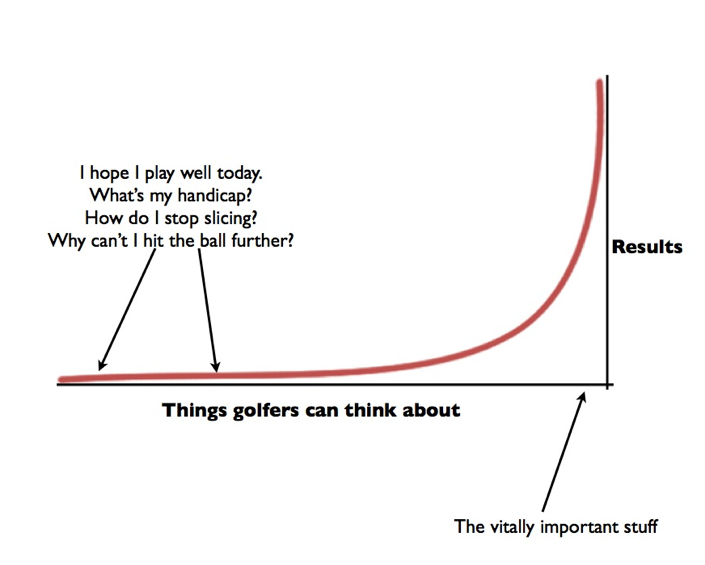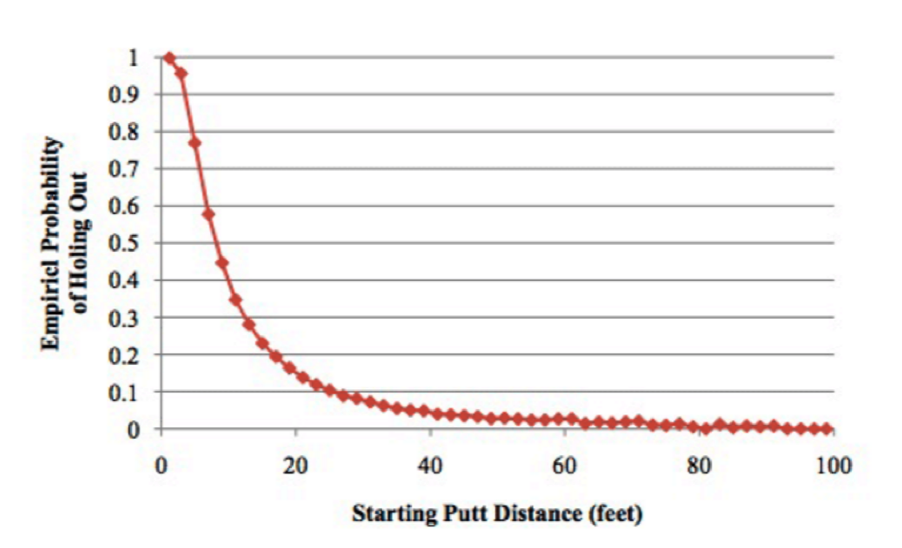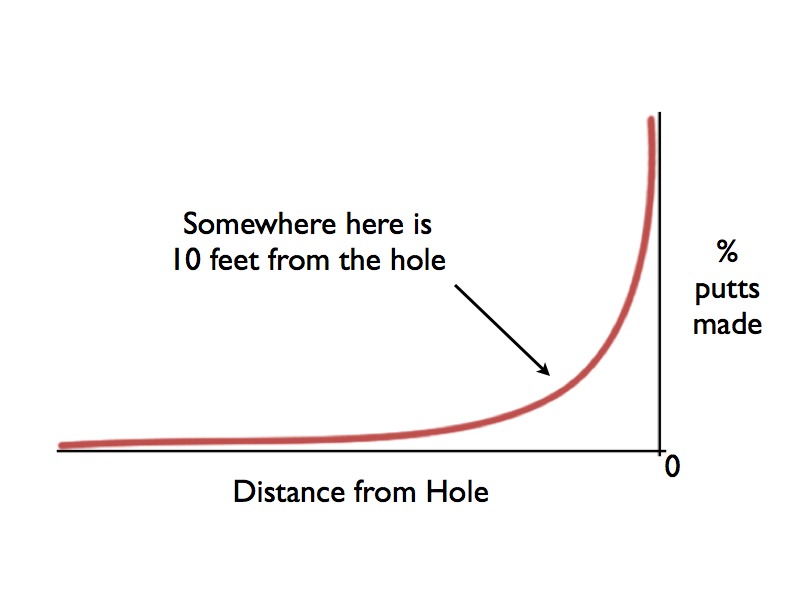Report #2: The Art Of Simple Golf
In the last report I shared with you my thoughts on unlocking a consistent golf game. In this report, I'm going to go deeper with you and share with you the most important discovery I've made in relation to making peak performance simpler. It's powerful stuff and I know you'll get a lot out of it.
Download report #2 by clicking on the link on the right. Or you can read the report in full by scrolling down.
If you have any questions or comments you can leave there here.
Downloads
 The Art Of Simple Golf
The Art Of Simple GolfIn this report I'm going to share with you my most important and profound discovery for golf improvement. This discovery has not only helped my golf game, improved my coaching but it has changed my life.
In This Report ...
You're going to learn my most important discovery in relation to golf learning. And funny enough, I learned this at a marketing seminar I really didn't want to be at. Check it out and let me know what you think.
[Part 2] The Art Of Simple Golf
Cameron here. In my last report I discussed the problems of traditional golf. How we’ve been brainwashed into thinking too much about our technique and not truly playing/learning how we’re designed.
I also introduced you to the Golf Performance Matrix which leads to better golf without all the bullshit. It’s ultimately how you can play consistent golf.
I’ve used these ideas to play my best golf and I’ve helped thousands of golfers from all over the world, from tour professionals, to weekend warriors see the light.
Today’s report is going to go deeper and I’m going to share with you the absolute best strategy I’ve found in relation to golf performance. This is so powerful that I now look at the world differently and I’m not sure I’ve come up with anything better.
Let’s get into it.
Back in 2010 I had a real job. I was working with a mate of mine as his marketing man. And the business was going well...
... we took things from a kitchen table into a multi-million dollar enterprise in months, not years. We could do no wrong and we thought we were rockstars.
As a bonus I got a trip to the USA. For tax purposes, I signed up to attend a marketing seminar but I was really hoping to avoid work - instead the goal was to play a little golf and catch up with friends. The marketing seminar however would change my life. Here’s the story ...
The seminar wasn’t really doing it for me - a lot of the speakers were obsessing about the latest fads in Internet technology and focusing on tricking Google into making a fast buck.
It was all too familiar to the golf industry. People looking for quick-fixes and hope. I was bored with it all and looking forward to getting to the bar for a cold one.
One speaker changed all that. Perry Marshall1 knocked my socks off and helped me see golf learning and performance (plus lots of other stuff) more clearly.
Perry Marshall was a once self-proclaimed boring engineering geek. He was struggling financially and unsatisfied with his job. He became a salesman and left behind the world of engineering. He hasn’t looked back.
He has since became the world authority on Google Adwords (those little ads that pop up on Google when you’re searching for certain topics) and has gone extremely deep on the subject. He can teach you how to set up an Adwords account, but he can also show you how to create a complete marketing system based on those ads - how to connect with your customer, how to get into their head, how to get them to like you and ultimately buy from you. It’s all fascinating.
Perry’s talk this day was not on Adwords. It really wasn’t about business at all but on something that at first seemed from left field.
He spoke about the Pareto Principle. The little taught subject that’s referred to as the 80/20 Rule. Here’s what it’s about:
For many events, about 80% of the effects come from 20% of the causes. It was first discovered by Vilfredo Pareto who found that 20% of Italians owned 80% of the wealth. But the principle repeats itself in all things - nature, business and yes, even golf.
And Perry Marshall had taken it further - he had gone deep. He even found that the 80/20 Rule is fractal, that there’s an 80/20 inside the 80/20. The example he used was that if 20% of your customers bring in 80% of your income, then 4% (20% of 20%) will bring in 64% of your income.
Perry was amazing and encouraged everyone to focus more on the 20% of customers (or the 20% of the 20%) rather than everyone.
It was at this point I started getting excited. As always, I was trying to think how this lesson could tie in with golf and coaching/learning. Thanks to my involvement in a biomechanical study, I was familiar with what a mechanical advantage was and the 80/20 rule seemed like a form of mechanical advantage.
One example: The scientists and I found that if a golfer softened his lead arm at the top of the backswing he could get a power advantage on the way down. You get more power with less effort because you’re able to start the club down more quickly when the arm is “soft”. It’s also easier to do so it’s completely win-win.
And right away I could see along my journey how much golf success had respected 80/20.
You don’t need to focus on 100 things to play great golf. You don’t even need to think about 10. Five is probably too many. But if you put your trust in the few really important “causes” your learning system doesn’t just kick into gear, it thrives.
You get better performance with the least amount of effort. You can move the biggest door with the smallest hinge. And this is what makes golf easier, more fun and ultimately leads to success.
The 80/20 Rule thinking comes from the business world. A world where success and performance are paramount. The business world wouldn’t accept getting worse before you get better.
It wouldn’t accept mediocrity.
It certainly wouldn’t accept years of effort, blood, sweat and tears without significant improvement.
And it despises constant failure.
But why do we accept mediocrity with our golf game? Why do we blame ourselves? Why do we struggle to get better, despite the effort?
Traditional golf instruction is stuck. There is an easier way. And for the most part none of this is your fault because the golf world has been too focused on the wrong thing. We’ve been brainwashed into thinking and playing golf one way when there’s a better and more effective approach right in front of us.
Perry Marshall finished his presentation by showing a visual representation. Below, you’ll see my version, changed to apply to golf.
Simply, there are a vital few things that give you the greatest bang for your buck. Learn to focus on these, and forget about all else, and I promise that your golf will never be the same again.
Most golfers will struggle to do this because they’re conditioned to think about lots of things. Sadly, most of these “other things” weigh you down and they just don’t help. And as I’ve discussed, the more of these things you add, the worse you’ll play.
Check out the graph on the next page.

Applying this to golf
I’ve applied this mindset to the entire game of golf with incredible results. But for the interest of brevity, here’s just one way I’ve made golf learning more simple.
We all want to putt better. It can be a black at. And when Perry placed his version of the graph on the screen, I immediately thought, “I’ve seen this thing before”. I realised that the golf scientist, Dave Pelz had used something similar to describe the putting game.
Here’s another graph.

Dave Pelz Putting Chart
I know the graph is around the other way (Perry Marshall encouraged us to switch to highlight the importance of thinking differently) but it’s almost identical to the 80/20 curve.
Anyway, here’s what it’s all about ...
You’re going to make almost all of your really short putts but the further you get from the hole, the less you’ll make. What’s surprising for many, is how quickly the numbers drop away.
And keep in mind, the numbers above represent the best players in the world. Amateur golfers are not going to be able to match these numbers. When I first saw this graph (in the early 2000’s) I had no idea about 80/20 thinking and about making my golf game simpler and easier.
To be honest, I ignored the numbers and thought I could out-putt the curve. I foolishly thought if I practised long enough and hit enough putts, I could make all sorts of putts consistently.
But I couldn’t. I was pushing things uphill and trying break the confines of human potential. And let me tell you, it was a maddening and frustrating process that never helped me putt better.
I wasn’t putting better because I was trying too hard and doing too much.
Making More Putts
My 80/20 thinking with putting is really simple.
Learn to make most of your short putts. You don’t need to worry about the tiny putts (because you don’t miss one footers), the key area is the 3-4 feet range. If you can make more of these you’ll be on your way. When you can do this, you’ll naturally make more 5, 6, 7, 8, 9 and 10 foot putts. You won’t make them all (you can’t) but you’ll hole your fair percentage.
What about the longer putts?
Great question. You should stop believing you can hole them. Not because they are impossible to make, it’s just that nobody can hole them consistently. Thinking this way frees up your system, helps you relax and you can focus on something way more important...
... two-putting.
If you can two putt the vast majority of the time (when you’re outside of say 10-15 feet from the hole) your putting game will never be the same again. Two-putting is key.

80/20 Putting Graph. Once you get outside of 10 feet from the hole, the chances of making the putt diminish.
That extra putt, the dreaded three-putt is what kills your score. But learn to get your first putt close, so you can get the next one is, is a perfect approach and will result in improved putting performance.
I’ve worked on this strategy with one of Australia’s best golfers (ranked in top 15 in 2015) and it was very successful. Where once this guy was frustrated at missing a bunch of 20 to 30 foot putts, he accepted this as normal. His focus became aligned on becoming better at the shorter putts, and more on two-putting the rest.
The end result was a more relaxed and calm golfer. He didn’t need to spend hours each week on the practice putting green (there’s just no need) and the nice side effect is he started rolling in more of the long ones too.
And the comments from others really bumped his confidence.
“You’re putting really well mate”
“You don’t miss. You are holing everything”
“He’s an awesome putter. His long putting is phenomenal”.
We laughed at all these comments because a few weeks earlier he was ready to quit. He thought his putting was horrendous and he had no chance of improving (because he had tried everything to fix it).
But learn to simplify and see what happens?
Not only can results come quickly, it happens without all the usual bullshit that is brainwashed into us.
long hours of practice
rebuild our technique
lots of thinking and analysis
getting worse before you get better
When you know how to simplify you can forget about all those other things you normally think about. You can live up to the KISS principle.
And surely this has got to be your mission?
To make golf more simple and fun so you give yourself a chance of playing your best and bringing something consistent to the golf course.
If you’re bringing lots of mental baggage, because your focused on the wrong things, and your overloading your system because you’re worried about every millimetre of your technique, then you have ZERO chance of playing decently.
ZERO
Sure, you can fluke the odd shot or even have a good round every now and then. But as we saw in my first report, this is not sustainable. You will invariably fall back into your wicked ways. You’ll be in a slump in no time.
I call this simplistic approach to learning/playing golf Automatic Golf. And I’m not sure any coach has spent more time attempting to simplify the game - to make it easier so we can get past all the instruction and the minefield of ideas available to us.
All this sounds too easy
This is the biggest objection I receive about Automatic Golf. It just sounds too easy.
Listen up. Golf is a skill like all others. It’s no different from driving a car, riding a bike or throwing a ball. And most of us can perform these skills well despite not needing to practice them much and we certainly don’t stress and worry about them.
These skills are automatic. We perform them without a lot of conscious thought. And once we’ve learned them, we can do them for the rest of our lives without complication.
I get that golf isn’t natural and we aren’t born with a golf club in our hand. But learning is natural. What I’ve presented so far helps you learn golf “naturally”. I’m passionate (and a little crazy about sharing my thoughts) because most golfers and the entire industry seems hell-bent on making it as difficult as possible when there is a much simpler way.
I’m almost out of time for today. In my third, and final report I’m going to give you a way to take this approach to your entire game and cover more of the questions that I’ve received.
Notification for the next report will land in your inbox soon. So please keep an eye out for it.
In the meantime, head over here and leave any thoughts/questions/comments. I’d appreciate it.
And be sure to approach putting with a much simpler mindset.
Thanks for reading,
Cameron Strachan



